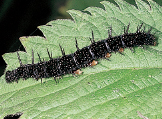
The butterflies illustrated on these two pages all pass the winter in the adult stage, often sleeping in sheds and gardens. They can be seen stocking up on nectar from michaelmas daisies and other late-flowering plants in the autumn, and they reappear to feed on aubretia and other spring flowers as early as February. At this time the butterflies often look a bit worse for wear, but this does not prevent them from courting and mating, and laying eggs as soon as their food plants appear.

Michael Chinery
The spiky black caterpillars of the peacock butterfly live communally on nettles when young, but disperse as they mature and then pupate on the stems.
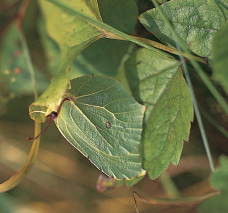
Michael Chinery
Brimstone
Identification: Male upperside brilliant yellow; female greenish white. Wings never open at rest.
Flight time: June–September and again in spring after hibernation.
Distribution: All but the far north of Europe.
Food plant: Buckthorn and alder buckthorn.
Caterpillar: Blue-green above and lime-green below, with a white stripe on each side.
Notes: Hibernates in shrubs where leaf-like underside gives good camouflage.

Michael Chinery
Peacock
Identification: The four eye-spots on the upperside ensure that this butterfly is instantly recognizable. The underside is almost black.
Flight time: June–October and again in spring after hibernation.
Distribution: All but the far north of Europe.
Food plant: Stinging nettle.
Caterpillar: Black and spiky with numerous white dots.
Notes: A strong-flying migrant.
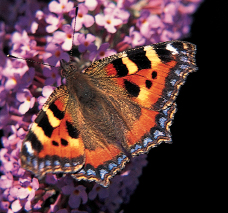
Michael Chinery
Small tortoiseshell
Identification: Look for the blue borders and the extensive black patch at the base of the hindwing. Underside is mottled brown.
Flight time: March–October; usually two broods.
Distribution: All Europe.
Food plant: Stinging nettle.
Caterpillar: Bristly black or dark brown with dense white dots and yellowish sides.
Notes: One of Britain’s commonest garden butterflies.
Michael Chinery
Comma
Identification: The jagged wing margins readily identify this species, named for the comma-shaped white mark under the hindwing.
Flight time: June–September and again in spring after hibernation; two broods.
Distribution: Most of Europe but not Ireland or Scotland.
Food plant: Stinging nettle, elm and hop.
Caterpillar: Black and orange with a white patch at the rear; spiky.
Notes: Summer butterflies often paler than here.
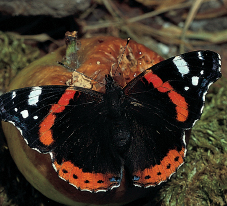
Michael Chinery
Red admiral
Identification: The vivid red patches on the velvety black background are unmistakable.
Flight time: May–October.
Distribution: All Europe.
Food plant: Stinging nettle; adult fond of fruit.
Caterpillar: Usually greyish-black but is sometimes paler; always spiny.
Notes: Once thought to be only a summer visitor to Britain, but now seems to hibernate here in increasing numbers, flying early in spring.
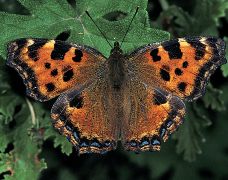
Ted Benton
Large tortoiseshell
Identification: This is larger than the small tortoiseshell, with no large black patch on the hindwing. Underside is mottled brown.
Flight time: June–August and again in early spring after hibernation.
Distribution: Most of Europe but a rare visitor to Britain.
Food plant: Elm, sallow and other trees.
Caterpillar: Black with orange streaks and spines. Gregarious.
Notes: Becoming rare everywhere.
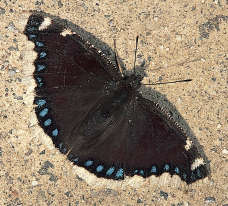
Ted Benton
Camberwell beauty
Identification: The cream border makes this species unmistakable.
Flight time: June–August and again in spring after hibernation.
Distribution: Most of Europe but only a rare visitor to Britain.
Food plant: Sallow and other deciduous trees.
Caterpillar: Black and spiky with large orange patches on the back.
Notes: Wing margins are paler after hibernation.
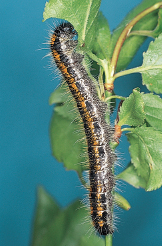
The caterpillar of the black-veined white butterfly is very attractive, but it can be extremely destructive to garden shrubs and fruit trees.

Identification: Only male has orange tips; the female is white. Hindwing mottled green below.
Flight time: April–June.
Distribution: Most of Europe.
Food plant: Honesty, sweet rocket, garlic mustard and various other crucifers – mainly the flowers and seed capsules.
Caterpillar: Bluish-green, speckled with black.
Notes: Rounded wing-tips distinguish female from other whites.
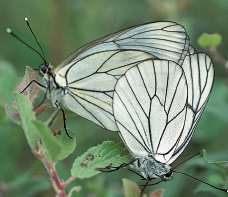
Black-veined white
Identification: Conspicuous black or brown veins, with no spots.
Flight time: May–July.
Distribution: Most of Europe except the British Isles and the far north.
Food plant: Blackthorn, hawthorn and other rosaceous shrubs, including garden roses.
Caterpillar: Grey and hairy, with black and orange stripes on the back.
Notes: Young caterpillars live in silken tents.
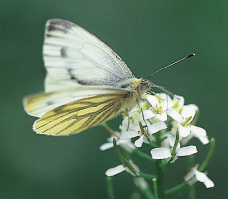
Green-veined white
Identification: Easily recognized by the green lines under the hindwing.
Flight Time: March–November; 2–3 broods.
Distribution: All Europe.
Food plant: Garlic mustard, cuckoo flower, water-cress and various other crucifers; rarely feeds on cultivated brassicas.
Caterpillar: Dull green, speckled with black.
Notes: Summer butterflies have much paler markings than shown here.

Small white
Identification: White upperside has a small black wing-tip and one (male) or two (female) black spots. Hindwing yellow underneath.
Flight time: March–October; 2–3 broods.
Distribution: All Europe.
Food plant: Numerous wild and cultivated brassicas, and garden nasturtiums.
Caterpillar: Dull green; a yellow stripe on back.
Notes: Summer insects are more heavily marked than spring ones.
Large white
Identification: Creamy white above, with large black wing-tip; female has two spots on upperside of forewing, but male has none.
Flight time: April–October; two broods.
Distribution: All Europe.
Food plant: Mainly cultivated brassicas; also garden nasturtiums.
Caterpillar: Yellow and black, gregarious for much of their lives (see here).
Notes: Adults are very fond of buddleia.
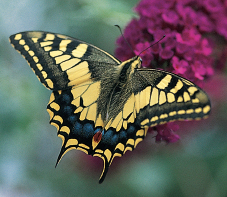
Swallowtail
Identification: The tails and the black wing-bases readily identify this large butterfly.
Flight time: April–September; 1–3 broods.
Distribution: Most of Europe, but only in Fenland in the British Isles.
Food plant: Various umbellifers, including fennel and wild carrot.
Caterpillar: Plump and green, with black rings and red spots.
Notes: A garden insect only on the continent.

Scarce swallowtail
Identification: Six black streaks on each forewing, and long tails on hindwing.
Flight time: March–September: two broods.
Distribution: Southern and central Europe; a rare visitor to the British Isles.
Food plant: Rosaceous trees and shrubs, including garden roses and fruit trees.
Caterpillar: Green and slug-like with red spots and yellow streaks.
Notes: Actually more common than swallowtail.
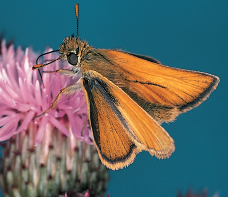
Small skipper
Identification: Bright orange upperside and orange-tipped antennae. Fast, darting flight and, like many skippers, rests with wings separated.
Flight time: May–August.
Distribution: Southern and central Europe; not Scotland or Ireland.
Food plant: Grasses.
Caterpillar: Pale green with yellow stripes; usually concealed in rolled leaf-blade.
Notes: Essex skipper has black tips to antennae.
Painted lady
Identification: The wing colour and pattern, with white spots near the tips, is unmistakable.
Flight time: April–October; two broods.
Distribution: A summer visitor to all Europe.
Food plant: Thistles and, less often, stinging nettle and mallow.
Caterpillar: Black and spiky, dotted with white and lined with yellow.
Notes: Probably unable to survive the winter in Europe; migrates from North Africa each spring.

Map butterfly
Identification: This butterfly exists in two very different forms: the spring brood (seen above) and the summer form which is dark brown with a cream or yellow band across each wing.
Flight time: April–September; two broods.
Distribution: Central and southern Europe; absent from the British Isles.
Food plant: Stinging nettle.
Caterpillar: Spiky black with yellowish stripes.
Notes: Named for the map-like underside.
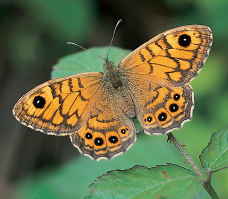
Wall brown
Identification: The eye-spots readily distinguish this from other orange and brown butterflies. The underside of the hindwing is largely grey.
Flight time: April–October; 2–3 broods.
Distribution: Most of Europe except far north.
Food plant: Coarse grasses.
Caterpillar: Bluish-green with white lines and two short ‘tails’.
Notes: The adult butterfly likes to bask on stones and bare ground.
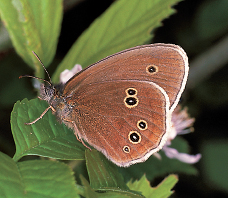
Ringlet
Identification: Readily identified by the band of eye-spots on the underside. Upperside is dark brown, sometimes with faint eye-spots.
Flight time: June–August.
Distribution: Most of Europe except far north.
Food plant: Various grasses.
Caterpillar: Pale brown and bristly, with a darker stripe along the middle and a white stripe on each side; two short ‘tails’.
Notes: Adult is very fond of bramble blossom.
Gatekeeper (or hedge brown)
Identification: There are two white pupils in each eye-spot. Female lacks the dark patch in centre of forewing (seen here in the male).
Flight time: July–September.
Distribution: Southern and central Europe; absent from Scotland.
Food plant: Various grasses.
Caterpillar: Pale brown and bristly, with darker spots, white side stripes and two ‘tails’.
Notes: Adult is very fond of marjoram flowers.
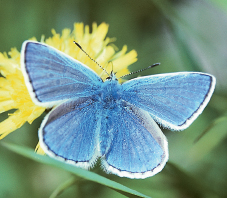
Common blue
Identification: Male is bright violet-blue; female is brown with marginal orange spots. Underside is grey or pale brown with heavy black spots.
Flight time: April–October; 2–3 broods.
Distribution: All Europe.
Food plant: Bird’s-foot trefoil, clovers and other legumes.
Caterpillar: Pale green and bristly, with a white side stripe.
Notes: Mainly rural gardens, mostly as a visitor.
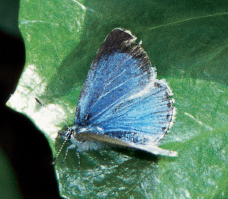
Holly blue
Identification: Upperside has a slight violet tinge; male has narrower black borders than female seen here. Underside powdery blue with elongate black spots.
Flight time: April–September; two broods.
Distribution: Most of Europe.
Food plant: Holly and various other shrubs in spring; ivy is main food of autumn brood.
Caterpillar: Pale green with a white side stripe.
Notes: The only blue normally in town gardens.
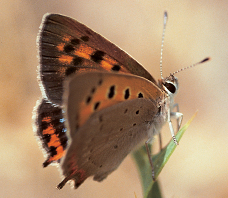
Small copper
Identification: Gleaming coppery forewings and barely-marked brown or greyish underside of hindwings distinguish this little butterfly.
Flight time: March–November; 2–3 broods.
Distribution: All Europe.
Food plant: Common and sheep’s sorrel; sometimes docks.
Caterpillar: Bright green with pinkish stripes.
Notes: Strongly territorial, an adult butterfly may defend a clump of flowers all day.